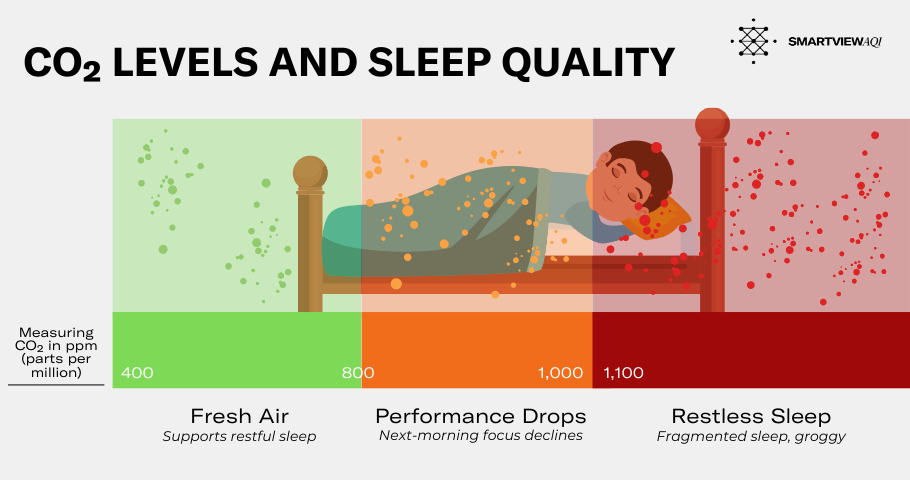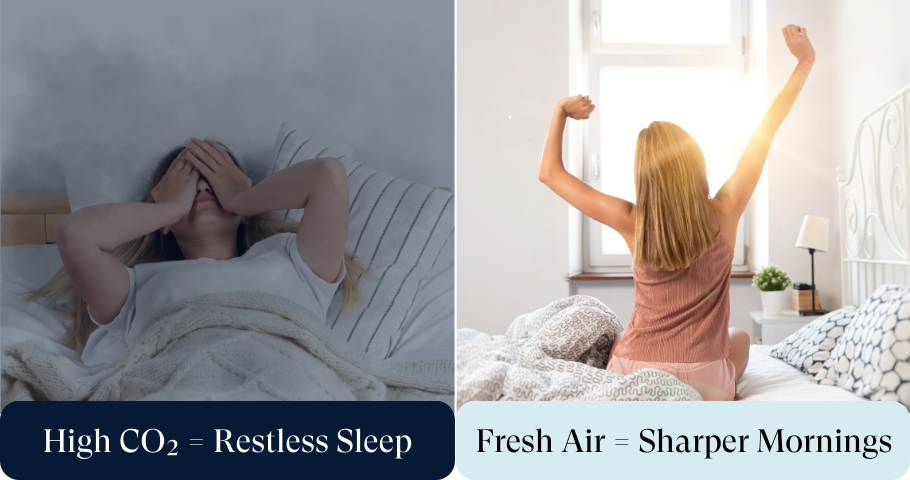CO2 and Sleep Quality: The Overlooked Connection
You know that feeling when you wake up groggy, like your brain is trying to boot up on dial-up internet? You went to bed early, skipped the late-night scroll, maybe even sipped chamomile tea. Yet morning still hits like a foghorn. That’s the connection between CO2 and sleep quality.
Here’s a twist: it might not be your habits at all. It could be the invisible guest in your bedroom—carbon dioxide (CO2). Think of your room like a snow globe. Shut the windows, close the door, and fill it with people. Shake it up all night (aka, just breathing) and watch the globe fill with an unseen haze. That haze? CO2. And your brain, much like the tiny figurine inside, spends the night buried under it.
Why Bedrooms Become Brain Fog Zones
CO2 doesn’t need much to pile up. A closed door, a couple of people sleeping, and a fan humming in “recycle” mode—it’s the perfect recipe for indoor CO2 to spike past 1,100 ppm, the threshold the ASHRAE association says begins to impair comfort and alertness.
In fact, researchers at Lawrence Berkeley National Lab found that people exposed to just 1,000 ppm of CO2 overnight woke with significantly lower cognitive performance the next morning. Imagine studying all night for a test only to show up with half your mental engine idling.
Real-world example? A family in Denver tracked their kids’ homework struggles and morning sluggishness. A sensor revealed CO2 levels creeping past 1,200 ppm every night. Cracking the door and shifting bedtime ventilation? The difference between cranky breakfasts and clearer mornings.
The Cognitive Cost of Nighttime CO2 and Sleep Quality
“Most people underestimate how much indoor CO2 affects mental clarity,” says Dr. Pawel Wargocki of the Technical University of Denmark, whose research has shown that elevated CO2 correlates with reduced sleep quality and next-day performance.
Symptoms of elevated CO2 while you sleep include:
- Restless sleep and frequent waking
- Morning grogginess and headaches
- Lower mood and slower focus the next day
And here’s the kicker: this isn’t just a “bad night.” Sustained CO2 buildup over weeks creates a cycle of fatigue that undermines everything from productivity to long-term health – so CO2 and sleep quality aren’t the end of your poor IAQ woes.

SMARTView AQI Science Spotlight
Study: ASHRAE Journal – “Using Indoor Air Quality Tactics to Sleep Better at Night, Perform Well the Next Day”
Breakdown (in plain English): When CO2 climbs above 1,100 ppm at night, sleep cycles get disrupted, and next-day performance tanks. It’s like sleeping in a tent at a music festival—warm, stuffy, and the air never quite feels fresh enough.
Takeaway: You don’t just “sleep through” CO2. Your brain pays the bill the next morning. That’s the unfortunate truth behind poor CO2 and sleep quality.
Solutions Beyond Cracking a Window
Yes, you can open a window, but here’s the catch: outdoor air isn’t always your friend. A great breeze at 11 p.m. can turn into wildfire smoke or pollen by 3 a.m. That’s why timing, tracking, and pattern recognition matter.
And that’s where SMARTView AQI shifts the game.
Instead of a dumb number on a screen, SMARTView AQI uses pattern recognition and real bedroom sensor data to flag when CO2 buildup is a recurring sleep issue. Over multiple nights, it can identify whether the culprit is:
- Closed-door under-ventilation (the “shut in with stale air” problem)
- Occupancy surges (kids piling in for movie night)
- System off-periods (when HVAC isn’t cycling at night)
If your bedroom CO2 consistently climbs overnight, SMARTView AQI issues a Sleep Air Quality Alert. Think of it as your room tapping you on the shoulder and saying, “Hey, I love being cozy, but we’re suffocating in here.”
What makes it different? SMARTView AQI doesn’t just alert—it cross-references outdoor 4-day AQI forecasts, so it can suggest:
- “Tomorrow night, crack a window after 10 p.m.—outdoor air will be cleanest then.”
- “Skip the open window tonight, the outdoor air is poor. Use a ceiling fan instead.”
That’s actionable, contextual advice—without you staring at a screen at midnight.
Health Outcomes of Good vs. Bad Sleep Air
When CO2 stays high overnight:
- Sleep cycles fragment
- Grogginess drags into mood and memory
- Productivity dips the following day
When CO2 is managed:
- Deeper REM cycles
- Sharper morning clarity
- Better long-term cardiovascular and cognitive health
It’s not just about sleep—it’s about how you live the next day.

A Smarter Way Forward—The SMARTView AQI Way…
The foggy mornings caused by CO2 don’t stop in the bedroom. They connect directly to the impact of CO2 on focus and mental clarity during the day (pillar blog). In fact, in our last piece—How Elevated CO2 Affects Brain Performance—we showed how the same invisible gas that dulls your evenings also drags down daytime decision-making.
Sleep and focus aren’t separate silos—they’re back-to-back chapters in the same story.
If your living room is a snow globe and your bedroom a stuffy tent, SMARTView AQI is the friend who cracks a window at the right time. Tracking bedroom CO2 patterns, spotting trends, and layering in outdoor air forecasts helps you take control of your sleep environment without the guesswork.
Cleaner air tonight. Sharper mornings tomorrow. Let CO2 and sleep quality be friends – not enemies.
Sign up free for SMARTView AQI and start seeing how your air really behaves—so your sleep (and your brain) can finally catch a break.
